Selections
Featured Products
Tips and Advice |
How to Grow Ornamental SunflowersWe frequently are asked how to grow sunflowers. Of course, after so many years it is pretty automatic for us. However, we realize that it can be challenging for novice gardeners who want to plant and enjoy sunflowers. Fortunately, sunflower is pretty easy to grow. The sunflower genus, Helianthus, evolved right here in North America and many species of sunflower are found throughout the United States. So, sunflower is adapted to most growing conditions. Most importantly are daylight, adequate water, and fertile soils. The sunflowers that we sell at SunflowerSelections.com are grown for all purposes. The hobby flower grower can try any of our bouquet or short stature sunflower varieties for use in the garden. We advise professional growers to test our sunflowers under their own conditions before committing to expensive mass plantings intended to generate income. There is no one way to grow sunflower, but there are facts about sunflower that we like to emphasize. 1. Poor growing conditions will affect the sunflower plant. Lack of fertility, lack of adequate moisture, and competition with weeds will all reduce the vigor of the plant. 2. Likewise, day length and daytime and nighttime temperatures affect the growth of the sunflower plant. If you live in south Texas or Florida, your sunflowers may be shorter or taller, or earlier or later than if grown in Maine, for example. So, if you like to read about sunflower experiences on an internet bulletin board, be sure to weigh the information carefully. 3. The sunflower plant responds to space. If you want a larger diameter of flower, grow sunflower at a wide spacing from competing plants. The stems will be thicker, too. Grow sunflower plants closer together to get thinner stems and smaller flowers. Generally, plants grown closer together will be taller, too, than when spaced apart. However, remember that thinner stems are more delicate and high winds might snap off the plants. And of course, branching sunflowers will make more branches when you space them apart. 4. Transplanting – Many growers like to start their plants early and transplant them to their gardens. It is very important to realize that sunflower plants make a central tap root that likes to grow straight down into the soil. Maximum growth is achieved when this process occurs without disturbance. Plant scientists know that growing conditions such as stress and day length as early as from three weeks after emergence can trigger the plants to flower earlier. So, if you like to germinate your plants in trays under lights be aware that transplanted plants will ALMOST ALWAYS be shorter in height when they flower than if they were planted directly into soil. And if your want to grow the REALLY GIANT plants like KONG and AMERICAN GIANT HYBRIDS, you will get the best growth by planting them directly into the soil in the garden so that their central tap roots are never disturbed. Our dwarf sunflowers like Junior, Firecracker, Baby Bear, and Munchkin grow well in six pack trays and easily transplant. Just 5 weeks from sowing you will have a firm root ball that easily separates from the tray. Check out the product page photos for Junior to see transplant trays ready in five weeks! 5. Soil Fertility – Over the years we have heard comments from growers that when they first grew sunflowers, the plants were big and lush, and now after 10 years they are smaller, and not as vigorous. They wonder if we have changed the genetic composition of the variety. The reality is that the fertility of the soil has probably changed. Remember when you cut sunflowers for flowers, you are taking a lot of biomass from the field – the leaves, the stems, and the heads. You need to put a lot of organic material and fertilizer (natural or synthetic) back into the soil to compensate for what you take out. Sunflowers are deep feeders. Over time they will literally wear out the soil if you do not practice good stewardship of your land. We found a great link that demonstrates nutrient deficiencies in sunflower. Bear in mind that many symptoms of soil deficiencies appear similar. And some even appear similar to symptoms of sunflower diseases. Use this link as a first stop, then see your local soil extension specialist. Sunflower Nutrient Toxicities and Deficiencies: http://www.usu.edu/cpl/research_hydroponics4.htm There are number of publications on the internet where you can gain more knowledge about growing ornamental sunflower. Cultural Links: http://extension.umd.edu/publications/PDFs/FS686.pdf http://www.oznet.ksu.edu/library/hort2/MF1084.PDF http://hort.ufl.edu/floriculture/specialty-cut/EP1421.pdf http://www.ksre.ksu.edu/library/crpsl2/mf2384.pdf Weed Control Link: http://www.ag.ndsu.edu/weeds/weed-control-guides/nd-weed-control-guide-1/wcg-files/6-Snfl.pdf/view http://appliedweeds.cfans.umn.edu/weedbull/Sunflower%202008.pdf http://www.sunflowernsa.com/uploads/resources/85/pest-control_1.pdf Disease and Insect Problems Being native to North America, the many species of sunflower have co-evolved with numerous insects and plant pathogens. Moreover, sunflower’s introduction as a crop plant into Europe, Asia, South America, and Australia during the last century has resulted in even more pests being discovered. Fortunately for sunflower growers, plant breeders have done a good job in the last 70 years by selecting strains that can withstand most sunflower pests. Wild species that have adapted to pressure from the onslaught of sunflower insects and pathogens have contributed greatly to the development of modern crop and ornamental sunflower varieties that also tolerate most challenges from Mother Nature. Sunflowers that are grown for cut flowers escape at least half of the serious fungal diseases that can plague sunflower when the heads are left to mature for seed harvest. Most common diseases that attack sunflower in the pre-flower stages are:
Nice links with photos of symptoms of diseases and pests sunflower pests are: http://www.sunflowernsa.com/growers/diseases/ http://www.agroatlas.ru/en/content/diseases/Olee/ To Pinch Or Not To Pinch?When you are at a garden barbecue you might have a guest ask you if you pinch your sunflowers. So, we need to talk about it. Most plant growers at some point in their horticultural careers have “pinched” back or removed flowers from marigolds or zinnias and other ornamental species. Likewise, they may have cut a branch or stem from a tree or bush. The result was new growth on the plant where the old plant part was removed. The idea of pinching sunflower is to promote more and longer branches producing a fuller plant. Branches will grow from the leaf axils below the point of the pinching when pinching is done early. For several reasons, any similarity to other ornamental species ends with the broad concept of pinching sunflower. First, sunflower pretty much is programmed to flower during the first three weeks of plant growth after emergence from the soil. Pinching will force more branches and retard flowering by a few days when done early, but very few sunflower varieties will initiate new growth once the plant has started to flower and flowers begin to senesce. Secondly, not all sunflower varieties will respond to early growth pinching. At SunflowerSelections.com we have grouped our sunflowers by stem type. Those that we have selected for branching are more likely to respond to pinching if you want to try it. Those that we indicate are single stem likely will respond very little to pinching. Genetically they are not programmed to branch even if you try to force the issue on them. We know that from experience you have to pinch the growing point of a branching sunflower plant early if want to see a beneficial result. Hopefully you have planned to pinch and given your plant plenty of space to develop those branches that you will force develop. Remember, branching varieties will branch. You don’t have to pinch them. However, if you want to influence the shape of the plant and the length of the branches by pinching, we recommend that you pinch the plants when there are 4-5 sets of true leaves. Using your fingernails, pinch into the growing point of the plant and remove the tip as shown in the photos below.
When Can I Cut Ornamental Sunflower?The simple answer to this question is to tell you that you should cut the flowers whenever you feel you want to bring them inside to enjoy! Home gardeners likely will follow this advice. It works fine. You can admire them in the garden for awhile, then bring them inside when the flowers are fully expanded to enjoy even more. However, the answer is never so simple when you ask SunflowerSelections.com. There are several factors to consider. First, almost all of the ornamental sunflowers at SunflowerSelections.com are pollen-free. That means that we have bred them to not produce pollen. This is an entirely naturally occurring trait that was discovered decades ago when sunflower plant breeders were crossing wild sunflower species with cultivated sunflower varieties much the same way bees would cross flowers in a field. However, careful observation showed that some plants from seeds of these crosses did not produce pollen when they flowered the next generations. This discovery became the backbone of technology upon which the hybrid sunflower industry rests today allowing the stable production of oil and snack sunflowers on millions of farm acres around the world. Researchers at SunflowerSelections.com saw more opportunity. Not only did the discovery of this trait allow us to make new hybrid color combinations in predictable ways, but it meant that we could offer pollen-free sunflowers to the home and professional sunflower grower. This eliminated pollen drop on tables and furniture in the home and meant even people allergic to sunflower pollen could now enjoy a bouquet of cut sunflowers. You might wonder how the sunflowers feel about this? Well, they still produce nectar deep down in the florets and the bees still visit those flowers to collect that nectar. And the flower will even make seeds if the bees arrive with pollen on their abdomens and legs from other pollen shedding plants in the neighborhood. Now, finally we can answer the question about when to cut sunflower. Professional cut sunflower growers want to cut flowers as soon as it is possible so that they can achieve the longest possible vase life in order to have time to transport, sell, and assure that their customers enjoy the open flowers in an arrangement or bouquet. Furthermore, cutting the flower at this early stage eliminates any chance that bees or other insects may have started to pollinate the sunflower florets. Such pollination would result in fertilization and the beginning of seed development which would hasten flower senescence and cause early petal drop. Sunflower can be cut when you first see the ray petals begin to push out of the flower disk. Ideally, the petals are at right angle (90 degrees) to the disk of the flower. We recommend that the plants not be stressed at cutting time. And we like to cut in the early morning or evening, avoiding the heat of the day. The stems should be placed immediately in buckets of ambient temperature or better, lukewarm water and kept out of direct sun. Cut plenty of stem length so you can trim when you arrange the flowers. What technique gives optimum sunflower vase life?Recipes for vase life of cut flowers are as numerous as stew recipes. There are literally dozens of suggestions and testimonials about how sunflowers should be handled after cutting to assure long vase life. Almost all growers agree that flowers are best when cut from plants that are not stressed. During the heat of summer it seems reasonable to assume that a stem cut from a plant will remain healthy longer if the plant is well hydrated at time of cutting. Not only does this mean that it is ideal that the plant being cut have adequate soil moisture available, but it also means that it is best to cut sunflowers in the early morning before the leaves on the plant begin transpiring – or losing water. Remember on bright sunny days, the sunflower plants are photosynthesizing and the demand for water in the plant is at its maximum. At SunflowerSelections.com we like to cut sunflowers in the early morning usually before 10 am. We avoid very cold water and very hot water. The best water temperature is 100 F to 110 F (37 C to 43 C). Generally we cut about 30 inches (75 cm) of stem and immediately place the cut end of the stems in water leaving the bucket in the shade of the plants while we continue cutting. Once we are out of the field , we strip all of the leaves leaving a few leaves at the top of the stem to provide fullness in the final bouquet. It is important to remove the leaves on the stem because if they are immersed under water they easily rot and shorten the life of your flowers. Likewise, if you leave too many leaves on the top of the plant above the water they serve to dehydrate and wick moisture out of the stems. The stems can be re-cut and the flowers placed for 20-30 minutes in a clean water solution (0.02% v/v) of hydrating agents like either Tween-20 or Triton X-100. This treatment aids in preventing premature wilting of the flowers. To extend the vase life of sunflower a number of commercial preservatives are available such as Chrysal Floral Preservative and Floralife Crystal Clear. Solutions made of these flower preservatives contain sugars for nutrition, bacteria fighting compounds, and slight acid in some form to acidify the water. There are numerous homemade recipes that combine the same kinds of nutrients and might be useful. Two that you might want to test to make your own decision are given below: Cut Flower Preservative Recipe #1
Cut Flower Preservative Recipe #2
Finally, remember that your flowers appreciate a fresh, clean start every three days or so. Change the solution in your vase and re-cut the ends of the stems to promote longer vase life. How do I dye my sunflowers?Undoubtedly you have seen dyed or tinted sunflowers. Usually they are tinted bright red as in the image below.
Like many flower species, cut sunflower will absorb colorants through its stems when the colorants are added to the water in which the stems are placed. This process should be done in a bucket in a place where you will not worry about a few errant drips or spills. While almost all sunflowers will absorb the colorant, you will have to experiment to discover your own technique. Many varieties absorb differently than others and your results can vary from variety to variety. Many professional growers who offer tinted sunflowers use colorants provided by Robert Koch Industries of Bennett, Colorado: If you find that you are not interested in large scale tinting of sunflower such as described by Robert Koch Industries, you can still experiment using common food dyes found in the bakery department of your local grocery store. You should consider the natural color of the sunflower petal when you tint. The varieties at SunflowerSelections.com offer a lot of possibilities. The closer to white the natural petal color of the sunflower, the more true will be the color of the colorant in the flower petal when it is tinted. Expect the nearly white petals of Moonshadow and Jade to look different than ProCut Yellow Lite and ProCut Orange when tinted with the same colorant. At SunflowerSelections.com we have tried many of the colorants from Robert Koch Industries just for fun. Our Starburst Lemon Eclair and Starburst Aura gave interesting results producing semi-double petals colored on the edges and tips as shown in the image above. Have fun being creative with your sunflowers from SunflowerSelections.com WE INVITE YOU TO CHECK BACK FREQUENTLY FOR MORE TIPS AND ADVICE ABOUT ORNAMENTAL SUNFLOWERS
|

































